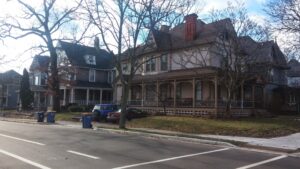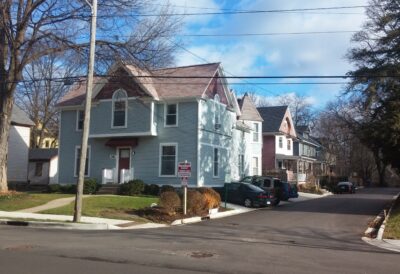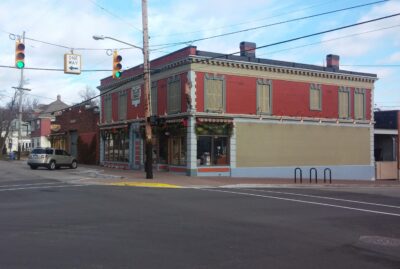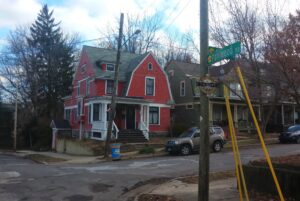
Great neighborhoods dedicate only the bare minimum amount of space to parking.
Visiting family in Grand Rapids’ Heritage Hill neighborhood over the holidays is always a great opportunity to dive into another city’s urban form. Â (Or at least that’s the excuse I give to get out of the house and away from family for a while!) The area, just east of downtown and south of the Medical Mile, is one of Michigan’s great urban neighborhoods, and it achieves that status despite (or because of) breaking several “everybody knows” rules of neighborhood planning.
Most communities’ planning & zoning documents assume an ideal neighborhood to be one that is dominated by owner-occupied single-family homes, with adequate yards for those families’ children to play in and driveways and garages for their cars to park in–any other neighborhood pattern is treated as somewhat less desirable, whether for reasons of “stability”, property values, maintenance standards, nuisance, or similar. Â Many people certainly do want to live in that type of neighborhood, but because our zoning has enforced this as the “good” neighborhood pattern for 70 years now, most of our cities have an oversupply of it, while lacking options for residents who want something else.

The “terrace” pattern in Heritage Hill and Midtown fits half a dozen additional houses into the center of a block, or into places where irregular terrain or other factors break the street grid.
Heritage Hill, and the adjacent East Hills and Midtown neighborhoods, showcase a different pattern: while most of the properties in this area look like “a house,” these neighborhoods have some of the highest residential densities in the city, and both homeowners and single-family homes are a minority.
This contrast comes from a few factors:
- Homes are placed on relatively small lots–many less than 1/10 acre.
- Most have very small “yard” areas, with front porches often within a few feet of the sidewalk, and the building occupying most of its lot.
- While there are larger apartment buildings scattered through the neighborhood, the majority of dwelling units are in duplexes or 3- or 4-plexes. Some of these are visibly constructed as “flats”, but most are houses.
- The historic streets are narrow, and off-street parking is limited, dedicating less of the neighborhood’s total acreage to asphalt.
Far from being less desirable as a result, data from GVSU’s Community Research Institute show these neighborhoods having above average shares of young, educated households and above average incomes; property values are strong and rising, and active renovation projects are visible on every block–just the type of talent attraction and local investment outcomes we hope to see from successful strategic placemaking efforts.

Martha’s Vineyard, “a corner store with a global wine selection”, anchors a neighborhood convenience cluster–pizza, bakery, and coffee–in Midtown.
The neighborhoods also feature small business districts tucked within them, some only a few buildings large and located on “small residential streets” that wouldn’t meet most standards for commercial development. These are both cause and effect of the neighborhoods’ success: having the ability to grab a quick coffee or a few grocery items for dinner within a short walk of home is a plus for prospective residents–and the high density of those residents provides the critical mass of customers that supports those businesses.
Obviously, the historic housing stock of these neighborhoods is hard to replicate (the photos here are far from the most “grand” examples in the area) though a lot of the ingredients for success can be adopted by other neighborhoods, especially where there is a historic street grid and housing to start with:

Neighborhood organizations use plaque programs both to recognize individual property owners’ contributions and build a shared sense of place identity.
- The small lot, duplex to 4-plex pattern that contributes most of the residential density here can be used to add new choices to many neighborhoods, filling the “missing middle” between single-family homes and larger apartment complexes. A form-based code can help ensure these options, either as conversions or new construction, fit in with the existing building stock.
- Look beyond zoning when considering the appropriate way to manage a neighborhood–here, the historic district designations and controls have clearly been the most significant regulatory contributor to success, rather than zoning.
- Adopt a Complete Streets approach that allows residents to walk, bike, or take transit to many destinations reduces the need to plan around parking–in these Grand Rapids neighborhoods, about 2/3 of households have only 1 car, or none whatsoever.
Even more than these specific actions, having an engaged neighborhood is critical–the “place governance” here arose in the late 1960s, when residents organized to prevent the widespread demolition of their neighborhood for redevelopment, as well as to reach out and recruit new residents in spite of mortgage redlining, and the place the neighborhood is today reflects the interests and tactics of residents then. Â Fortunately, not all organizing for place needs to arise from crisis.